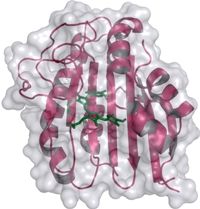Precious metal could lead to next generation of cancer treatments
A precious metal which has never before been used in a clinical setting is being developed as an anti-cancer agent by Warwick researchers. The metal, osmium, is closely related to platinum, which is widely used to treat cancers in the form of the drug cisplatin. Most famously, the cyclist Lance Armstrong was treated with cisplatin for testicular cancer.
Now the researchers, based in the Department of Chemistry, at the University of Warwick, are working closely with Warwick Ventures, the university’s technology transfer office, to seek partners to help develop the potential of osmium through more extensive biological tests.
Professor Peter Sadler, of the Department of Chemistry, explained: “Although cisplatin has been proven to be a very successful treatment; it is not useful for all kinds of cancer. It is also quite a toxic therapy, which can produce side effects and, from a clinical point of view, cells can also become resistant to platinum.”
Osmium, with its special chemical properties, offers a new potential solution to an unmet clinical need. It has shown huge promise in treating several different types of cancer cell, including ovarian and colon cancers which have been developed and tested in the laboratory. The metal also has another advantage in that it is a much cheaper alternative to platinum.
Professor Sadler, along with post-graduate researcher Sabine van Rijt, is working to develop new compounds using Osmium, which they hope will lead to the development of drugs which could be used in combination therapies alongside existing drugs such as cisplatin.
“The compounds we have been developing are very promising,” says Sabine van Rijt. “We’re building a picture of how different compounds might interact with DNA in cancer cells. By making changes to the coating, or ligand, on the metal, we can also affect not just how it interacts, but the rate of interaction. During this design process we can also make changes which can control the activity of the compound.”
She added: “Another advantage is that these compounds are not cross-resistant with platinum. They kill the cancerous cells in a different way, so they could be used alongside platinum in combination therapies.”
Most read news
Topics
Organizations
Other news from the department science

Get the life science industry in your inbox
By submitting this form you agree that LUMITOS AG will send you the newsletter(s) selected above by email. Your data will not be passed on to third parties. Your data will be stored and processed in accordance with our data protection regulations. LUMITOS may contact you by email for the purpose of advertising or market and opinion surveys. You can revoke your consent at any time without giving reasons to LUMITOS AG, Ernst-Augustin-Str. 2, 12489 Berlin, Germany or by e-mail at revoke@lumitos.com with effect for the future. In addition, each email contains a link to unsubscribe from the corresponding newsletter.


















































